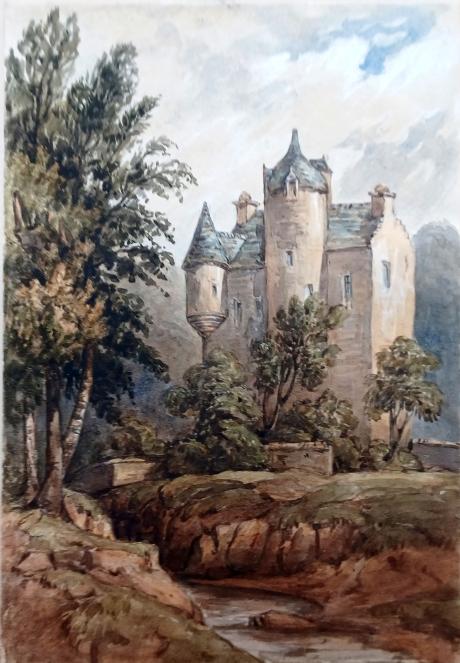inscribed " Grandtully Castle" a page from an album inscribed in the frontispage "F W Staines 3 Uplands St Leonards on Sea"
Amelia Jackson, Nee Staines (1842 – 1925) and thence by descent
Grandtully Castle is an historic building in Grandtully, Perth and Kinross, Scotland. It is a Category A listed building dating to 1560. An earlier castle stood around 1 mile (1.5 kilometres) east and dates from 1414; only its foundations remain.
The current castle consists of a Z-plan three-storey towerhouse of 1560, extended in 1626 to create a fortified house.In the calmer world of the 19th century, extensive additions were made in the 1890s in the Scots Baronial style by Leadbetter & Fairley.
The lands and castle belonged to the Stewart family from the 14th century, Thomas Stewart of Grandtully being mentioned in 1587. The castle was used by the Earl of Mar in the Jacobite Rising of 1715 and by Bonnie Prince Charlie in the 1745 rebellion.
In the early 1860s, the estate was rented by Duleep Singh, the last Maharaja of the Sikh Empire, known as the Black Prince of Perthshire. He had previously lived at nearby Castle Menzies.
The property was modernised internally in the 1920s. It is now divided as private flats.
It is said to be the basis of "Tully-Veolan" in Sir Walter Scott's "Waverley" novels.
Grandtully (pronounced as "Grantly" and sometimes also spelt "Grantully") is a small village in Perthshire, Scotland.
It is situated close to the River Tay, about 3 miles (5 kilometres) from Pitlochry. It has a population of approximately 750 inhabitants.
Parish Church
Grandtully has a Church of Scotland parish church; it is now part of Grantully, Logierait and Strathtay Parish (within the Church of Scotland's Presbytery of Dunkeld and Meigle).
St Mary's church


In Nether Pitcairn, 3.2 km south-west of Grandtully, there is a church built by Alexander Stewart of Grandtully in, or shortly before, 1533.
It is a low and outwardly unassuming white washed building that contains a wooden tunnel vault ceiling with tempera paintings from the early 17th century commissioned by William Stewart. The paintings show scenes and persons from the bible intermixed with the coats of arms of kings and noblemen, and in addition an abundance of birds, fruits and angels, all depicted in a renaissance style with cartouches and imitated metal work. The paintings were restored in about 1950.
Main article: Grandtully Castle
Dating to 1560, although an earlier castle stood around 1 mile (1.5 kilometres) east and dates from 1414; only its foundations remain.
Notable people
- The Drummond-Stewart baronets
- Sir William Drummond Stewart of Grandtully Castle, and his son,
- George Stewart, recipient of the Victoria Cross
Francis William Staines was the last of a family of merchants from the City of London. Not only was he a successful businessman but he possessed a large independent fortune, such that he could devote his time to the cultivation of his talents in music and art. He was a brilliant amateur violinist, and also loved to spend much of his time painting. His daughter Amelia and her mother accompanied Mr Staines as he travelled throughout the country finding subjects for his painting. One area of the country that they visited frequently was Scotland and the Lake District, and Amelia grew particularly fond of the dramatic landscape of the Fells. Skelwith Bridge with the view of the hills around it 43 was one of her father’s favourite scenes. He painted landscapes and maritime paintings , exhibited 11 works at the RA including views on the Italian Coast, address in London, Hastings and St Leonards on Sea Susssex.

